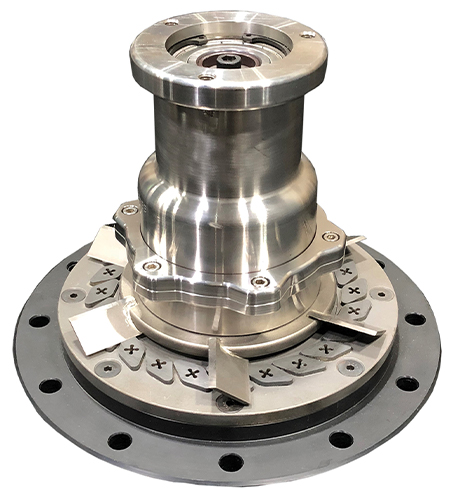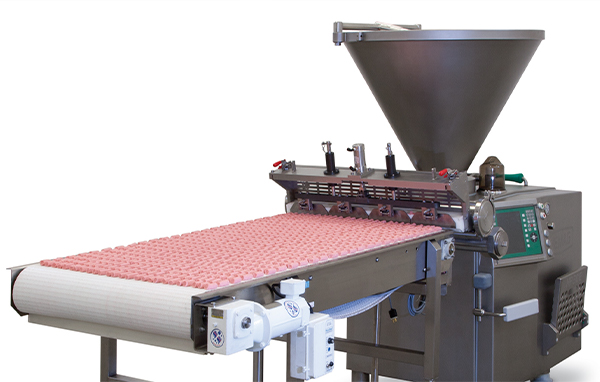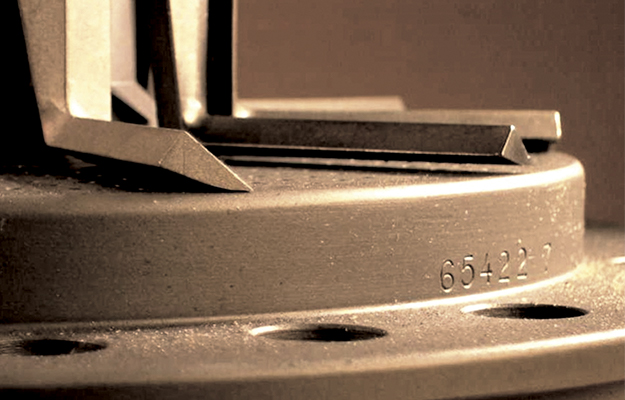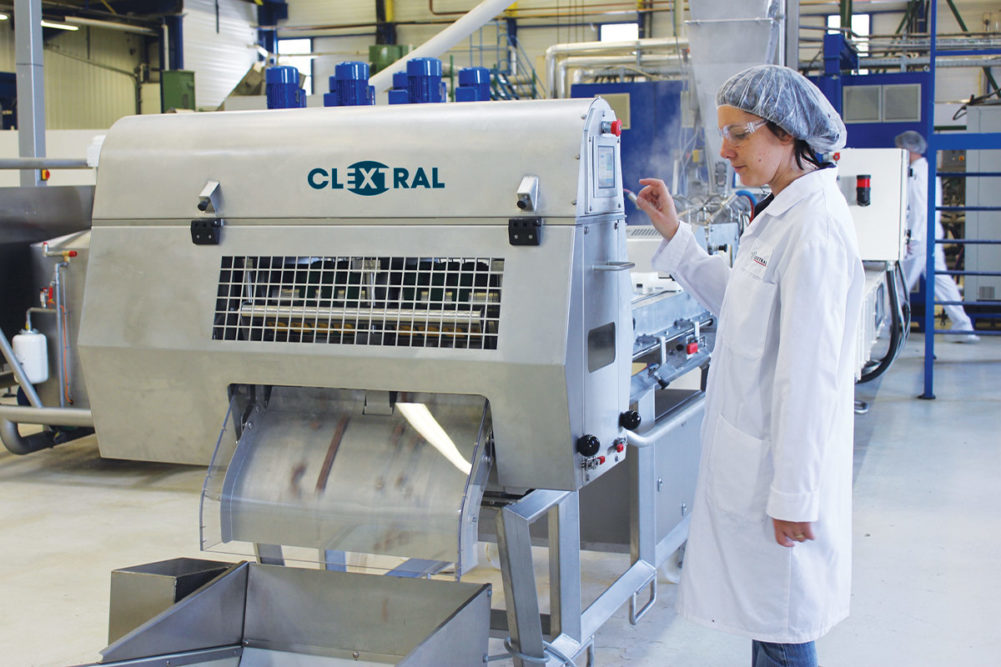This article was published in the September 2019 issue of Pet Food Processing. Read it and other articles from this issue in our September digital edition.
The same machines used to process human food are sold for pet food applications as well, so pet food processors usually have similar concerns as traditional food processors, says Mike Jacko, vice president, applications and new product innovation, Urschel Laboratories Inc., Chesterton, Indiana.
“They are looking for increased throughputs, increased usable product,” he says. “They want machines that are simple to operate and maintain to decrease labor costs. They need robust commercial cutting equipment with a solid cutting principle they can count on throughout rigorous production runs.”

Sizing solutions
Manufacturers of equipment for cutting and sizing pet food and treats explain their latest offerings and how they work to ensure quality, consistency and food safety.
Patrick McGady, national sales manager, Handtmann Inc., an independently operated subsidiary of Albert Handtmann Maschinenfabrik GmbH with headquarters in Lake Forest, Illinois, says the company’s servo-controlled Handtmann VF 800/FS 510 Multi-lane Forming Solution produces dimensionally stable skinless pet food snack sticks, bricks and bites with precise shapes and portioning accuracy.
“It offers the product handling benefits of Handtmann’s gentle vane cell that delivers a visible premium-quality difference while providing reliable gram-sensitive portioning accuracy,” he says. “This combination is especially appreciated by pet food processors using expensive human-quality ingredients because they can now virtually eliminate underweights safely while dramatically minimizing overweights – all while operating within the narrowest of min/max parameters. Our feedback is that processors’ ability to virtually eliminate rework is having a much bigger impact than they originally thought.”
Handtmann’s VF 800 Vacuum Filler/FS 510 Forming Solutions let processors change shapes quickly with its “slip‐in” forming nozzles and touchscreen product changes at the control panel. “Especially for pet food snack and stick processors, the travelling knife and wire-cutting options available for the VF 800 Vacuum Filler/FS 510 Forming Solution mean one line provides all of the flexibility that’s needed when forming for a variety of species and formulations in a variety of shapes at volumes requiring high-speed automation,” McGady says.
Recent pet food cutting applications on Urschel cutting equipment include whole-muscle diced meat and veggie dehydrated pet snacks, fabricated — extruded and cut snacks — and high-quality cat foods using real chicken breast, pork and beef. “Our large Comitrol Processor Model 9300 is being used to reduce meat scraps, bone for dog food nibbles, and coatings,” he says. “Pet food manufacturers tell us processing similar meats for pets as humans is much more profitable. Vegetable shreds are commonly processed on the Model CC Slicer, and high-fat meat products are routinely diced on the Affinity Dicer.”
Ever Extruder, Festus, Missouri, offers a SuperCut System that is adaptable to many existing die assemblies already in use in production plants, as well as complete die/cutter/hub systems that could be implemented with a complete Ever Extruder Extrusion Line, or onto other brands of equipment, says Alan Kirkland, engineering manager for the company.
The Ever Extruder system includes a self-tensioning, self-aligning hub that controls the set-up and pre-load of the cutters against the die plate, adding consistency and confidence that the cutting system is correct and ready for production, he says. The cutters are offered in low-count to high-count configurations to allow the customer to pick the best match for the products they are making. “Controlling cutting speed is critical to maintaining product quality, reducing product deformation and preventing clumping of the product after it is cut,” Kirkland says.
Ever Extruder also offers carbide die-plate options for intricate or high-volume products. “This solid carbide technology provides a wear-resistant material where the die cavity details don’t change, so product specifications are always consistent,” he says.
Additionally, Ever Extruder offers Flow-Valve technology with its Sanitary Start-Up Discharge System (SSDS). “This system offers a small, simple and removable valve that is positioned just before the die assembly,” Kirkland explains. “This technology offers great sanitation control, safety control and flexibility to the operator when running the extruder, and helps to control cook, density, shear and cellular structure of the kibble or pellets being made. This tool can be a key part in ‘dialing in’ the products to control bag fill, drying and absorption of fats, oils and flavors that may be added after cutting.”
Canton, Massachusetts-based Reiser offers customers a flow divider (or waterwheel) designed to divide a single flow of product into multiple lanes to give exact width and thickness, says Robert Freiberg, application specialist. “Length control and/or weight control of the portion is achieved by the Vemag positive displacement pumping system,” he says. “The accuracy of these dimensions allows for uniform thermal processing as well as cooling.”
Daniel Tramp, technical sales, companion animal division, Wenger Manufacturing Inc., Sabetha, Kansas, says the company offers knife blades for short goods that can be flexible or rigid and travel along the surface of a die to cut the product as it emerges from the die orifices. For long goods, Wenger offers two technolgies – a guillotine cutter and a rotary belt cutter. The guillotine cutter is good for up-and-down cuts on long goods, Tramp says. “As product cools, this cuts straight down and then retracts. Usually, it cuts multiple streams of product at once and then moves on.”
“With the desire now for high-meat and high-moisture products, there has been a trend to more gentle handling of this tender product until it is dry,” says Galen Rokey, Wenger Manufacturing, Inc.
Galen Rokey, director of process, companion animal division, Wenger, says the rotary belt cutter features a rotary knife on a conveyer rotating at high RPMs. “This fits the trend in pet food for products to look more rugged and handmade,” he says. For sizing, Wenger offers a back-pressure valve and inline sampling for the management of size and shape of a product as it exits the extruder die and enters the cutting area. “With the desire now for high-meat and high-moisture products, there has been a trend to more gentle handling of this tender product until it is dry,” Rokey says.
Sylvie Brunel, Ph.D., product and process development manager, Clextral, Tampa, Florida, agrees and says the company’s cutters have optimized designs to preserve the product shape during cutting and transfer. “This is critical as the product exiting the extruder is typically hot and often in a malleable state,” she says. “Our Evolum die-face cutters are designed to allow fine-tuning of the blade position during operation to ensure product consistency, and the flexibility to start the extruder, then quickly and safely position the cutter in front of the die.”
Clextral offers several styles of cutters that are used for different products, but die-face cutters are used for most pet food products, Brunel says. “These operate at the extruder die and work in conjunction with the die to create many product sizes and shapes. Pincher/cutters are used for filled (co-extruded) products to shape and crimp the product into the desired shape,” she adds.
Clextral also offers a treat cutter specifically for extruded pet treats. “This is a clip-on module that cuts treats after they have been cooled to optimal cutting temperature,” Brunel says. “This high-performance cutter has an off-center blade that ensures a continuous and perfectly straight cut, plus specific motor technology to drive the blades, providing top flexibility at a wide range of speeds.”
Trend tracking
The shift in pet owner preferences toward fresh and human-quality pet food products is increasing the pace of equipment changes as many pet food processors are developing new products and operating with new processing standards, McGady says. “These changes require equipment solutions that not only meet what are very different food safety requirements and production demands but must also operate with the precision and efficiency required by ever-stricter business performance demands when using more expensive raw materials,” he says.
Furthermore, McGady says the power of automation and the precision of data-driven performance are starting to redefine processing efficiency in ways that will dramatically change processing operations. “Smart software that can link critical processing information to plant, enterprise or cloud-based process optimization initiatives is becoming more necessary just to maintain operational competitiveness,” he says. “And now, intelligent planning, monitoring and control systems for filling departments — like our Handtmann HDS family of Digital Solutions — are customizable so they can efficiently address the many and varied production management concerns of even the most niche players.”
The use of servo motors with Reiser’s Vemag systems have allowed processors to increase portions per minute (or lbs. per line hour) and improve weight control, Frieberg says. Servo motors on its waterwheel allow control of the cutting system as well. “The raw materials in pet food are known to have high calcium and sinew content,” Frieberg says. “With the combination of an angled shear bar and controlling the cut-off knife with a servo motor, these raw materials are no longer a concern. Reiser’s engineers have developed gauging blocks that deliver portions that look like random pieces but with the same portion weights, and each portion cooks at the same rate.”
In addition, Freiberg says the development and use of an alginate co-extruded casing is becoming a new standard for pet treats because of the ease of changing the portion weight based on animal size. Also, the handling of an alginate casing product is accepted more by vegetarians than a beef-based casing, he adds.
Brunel says the trend of adding fresh meat to kibbles and treats has created new textures and product styles that may require adaptation of cutting techniques. “New and unique shapes attract the attention of pet owners and provide new ways for manufacturers to differentiate their products,” she says. “Also, dual-textured foods are popular, which we make through co-extrusion and form and cut with a pinching former/cutter.”
Jacko agrees that pet food processors are creating more uniquely shaped cuts to differentiate themselves. “We offer an on-site, free-of-charge product test cutting facility where customers can see different types of cuts on various models of Urschel machinery,” he says. “We frequently work with R&D to assist in the creation of new SKUs. We project an increased amount of test cutting as more specialty ingredients enter the market.”
Knife knowledge
Best practices for using these manufacturers’ equipment to optimize product quality, consistency and food safety include the maintenance of knives used in the dies of extruders.

A quick, 15-minute check by the operator can make all the difference, Rokey adds. “The RPM of the knives is important too,” he says. “If the RPM is too fast, then you will have pieces that are too short and accelerated blade wear. If it’s too slow, knife blades disrupt product flow as it emerges from the die and create a rounded, mushroom-topped product.”
As for food safety, Rokey says the cutting operation requires proper shielding and, if knives aren’t regularly replaced, they can get worn down and pieces can break off and get into the product stream. If a knife fails, use of a downstream x-ray or metal detector can keep fragments from getting into a product stream and avoid a recall, he adds.
What’s next?
Rokey says he sees the potential for water jet (or water knife) cutting technology for long goods. But this will require additional food safety steps downstream.
Kirkland says he can imagine a pet food and treat market filled with more “custom products” developed to cater to specific breeds of animals. “The focus on quality of finished products, raw ingredients used in the products and the humanization of pets are all pushing the industry to keep improving the products that are offered,” he says.
Find more articles related to pet food processing equipment on our Equipment page.




